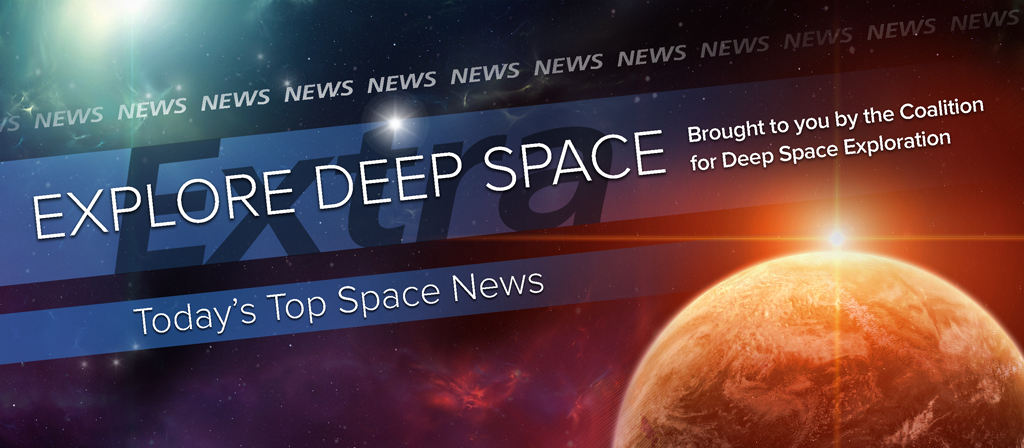Today’s Deep Space Extra offers the latest reporting and commentary on space related activities from across the globe. The Coalition for Space Exploration to formalize organization. Cassini, the long running U.S., European and Italian spacecraft mission at Saturn, successfully soared within 30 miles of the surface of the moon Enceladus on Wednesday to sample an icy spray coming from the South Pole. Scientist associated with the European Space Agency’s Rosetta mission say their spacecraft has detected molecular oxygen on the comet 67P/Churyumov-Gerasimenko. Surprisingly youthful stars have been detected at the center of the Milky Way galaxy. NASA’s Scott Kelly and Kjell Lindgren completed a seven hour spacewalk outside the International Space Station on Wednesday. NASA astronaut Scott Kelly sets a new U.S. spaceflight record. The U.S. House and Senate have reached an agreement on commercial space legislation that endorses a 2020 to 2014 extension of International Space Station operations.
Join us for a #SpaceChat today at 3:00 p.m. EDT with aspiring astronaut Abigail Harrison on Twitter. @AstronautAbby will be chatting about The Mars Generation. Participate by following hashtag #SpaceChat and @XploreDeepSpace.
Human Deep Space Exploration
Coalition for Space Exploration takes steps to ensure broad support for deep-space exploration
Spaceref.com (10/29): The Coalition for Space Exploration announced formal steps to provide a unified voice for the deep space exploration industry. The organization is seeking 501 (c) 6 status, appointing an executive director and changing the name of the organization to the Coalition for Deep Space Exploration.
Unmanned Deep Space Exploration
Cassini survives daring flight through plumes of Enceladus
Spaceflightnow.com (10/28): The joint NASA and European Cassini spacecraft successfully dashed through an icy spray erupting from the South Pole of Saturn’s ocean covered moon Enceladus on Wednesday. Cassini’s observations may help scientists determine whether Enceladus is a host to a habitable environment.
Cassini seeks insights to life in plumes of Enceladus, Saturn’s icy moon
New York Times (10/28): The Cassini spacecraft’s dash through water streaming from cracks in the icy surface at the South Pole of Enceladus offers a peek at the possibility for life on another world. Enceladus is a geologically active ice and ocean covered moon of Saturn. The U.S. and European spacecraft, now orbiting Saturn, made its closest pass by the moon’s surface on Wednesday. Scientist estimate it could take them weeks to decipher their findings.
Oxygen found on comet in Rosetta mission: ‘Most surprising discovery … so far’
Los Angeles Times (10/29): The European Space Agency’s Rosetta spacecraft has detected molecular oxygen in the vapor rising from the comet 67P/Churyumov-Gerasimenko. Rosetta rendezvoused with the comet in August 2014 and later dropped a small lander to the surface. Rosetta is tagging along as 67P travels around the sun. The discovery of normally reactive oxygen in molecular form was not expected, according to scientists.
Astronomers make a remarkable discovery in the center of the Milky Way
Washington Post (10/28): Astronomers are expressing surprise at the discovery of a disk of young stars at the center of the Milky Way galaxy. It was believed “the center” was the realm of older stars. But a class of Cepheid variable stars detected may be as young as 25 million years.
Low Earth Orbit
Space Station astronauts carry out extended spacewalk
CBS News (10/28) U.S. astronauts Scott Kelly and Kjell Lindgren carried out most of a wide ranging spacewalk agenda on Wednesday, including an extension of data and solar power cables to the site for a future docking port for Boeing and SpaceX spacecraft now in development to transport astronauts to and from the International Space Station. The spacewalkers also added protective insulation to the station’s Alpha Magnetic Spectrometer, a cosmic observatory. The messy lubrication of a grappling mechanism of the station’s robot arm forced the spacewalk into overtime.
After 7 months, is Scott Kelly wondering what he’s gotten into?
Ars Technica (10/28): NASA astronaut Scott Kelly established a new U.S. record for a single spaceflight, following Wednesday’s spacewalk outside the International Space Station, his first. Kelly surpassed the 215 day mark set by former NASA astronaut Mike Lopez-Alegria on the space station in 2006-07. Kelly and Russian cosmonaut Mikhail Kornienko are in the midst of a near yearlong stay in orbit that began on Mar. 27.
Commercial to Low Earth Orbit
House and Senate reach agreement on commercial space legislation
Spacepolicyonline.com (10/28): The U.S. House and Senate have reached a compromise on commercial space legislation. However, the details have not yet been made public, according to the report. The measure includes a proposed extension of NASA led International Space Station operations from 2020 to 2024.

